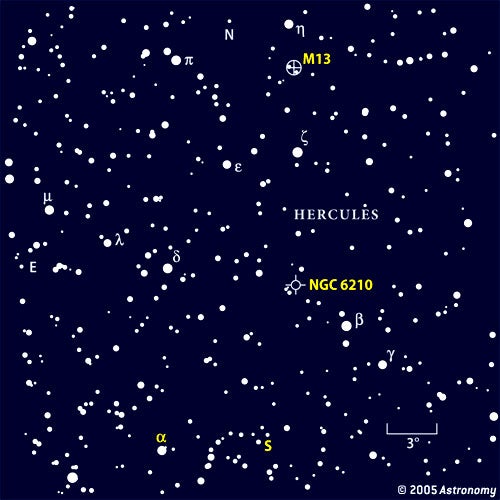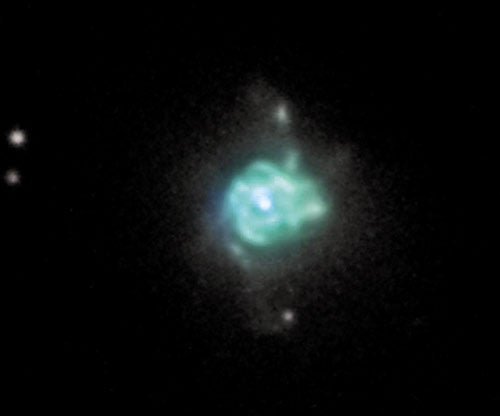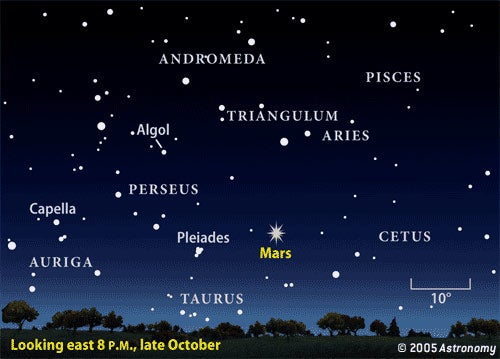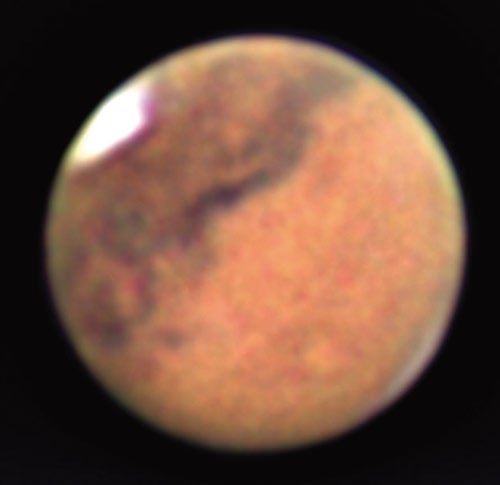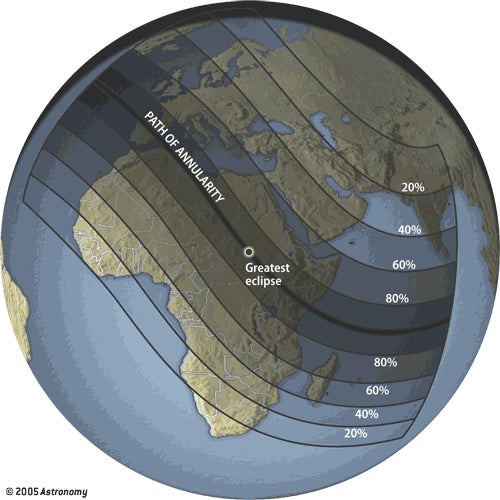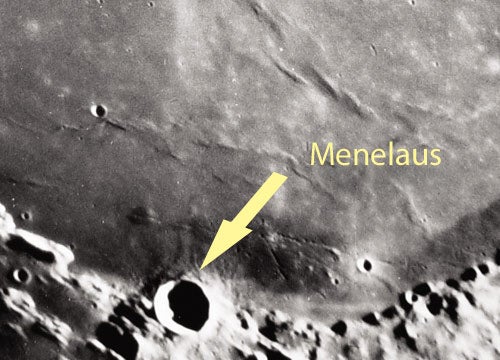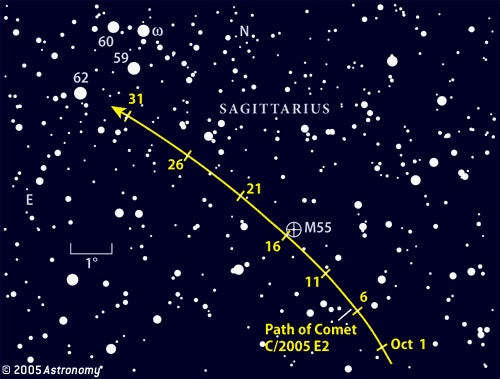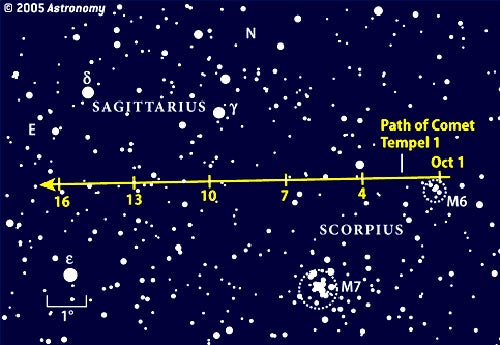Viewing a non-total solar eclipse poses danger to your eyesight. Use a good solar filter if you watch this event directly. You can pick up inexpensive but high-quality solar-eclipse “glasses” at most planetaria.
On the morning of October 17, a black shadow moves slowly across the Moon’s face. The darkness takes a small but noticeable bite out of the Full Moon starting at 7:34 a.m. EDT (4:34 a.m. PDT). Our only natural satellite passes just inside Earth’s shadow, in what astronomers call a partial lunar eclipse.
The best views of this eclipse come from lands rimming the Pacific Ocean and on Pacific islands. People in the western half of North America will see the entire eclipse, which wraps up at 5:32 a.m. PDT. Farther east, the Moon sets before the eclipse ends. Yet even from the East Coast, careful observers will see the Moon’s southern half dim a bit just before it sets.
Have you noticed what looks like a plane’s landing light in the southwest about 45 minutes after sunset? This beacon is actually our sister planet, Venus, whose cloud-choked atmosphere reflects most of the sunlight hitting it. Point a small telescope toward the planet, and you’ll see something that looks like a miniature, bloated half-Moon. On the evening of October 6, use binoculars to find a thin crescent Moon-sharing the field of view to the lower right.
The quick, fiery trails popularly known as “shooting stars,” and officially as meteors, result when tiny dust motes burn up in Earth’s upper atmosphere. When our planet crosses a dust stream ejected by a comet, we see a meteor shower. On the morning of October 21, dust from Comet Halley should produce 5 to 15 flashes per hour. The meteors emanate from the celestial hunter, Orion, so astronomers call them the Orionids. A waning gibbous Moon will drown out fainter meteors, so the show won’t be as good as in some years.
Earlier in the month, Earth may sweep through a dense dust trail left behind by Comet 21P/Giacobini-Zinner. Astronomers calculate we’ll barely miss it; but just in case, keep an eye on the sky the morning and evening of October 8. A dark sky will help you see any outburst from the Draconid meteor shower.
Early morning risers will see Saturn gleaming high in the south. Through a telescope, the rings appear noticeably less open than they did a year ago.
A starry sky
Who can resist seeing countless stars packed into a tight ball? A telescopic view of the grand globular cluster Messier 13 always draws satisfied sighs, even from experienced observers. It’s a great way to start an observing session. But instead of hopping along the road to the next object in the Messier catalog, let’s veer off the beaten path and put some color into your telescope.
Don’t let the fact that stars can’t be green stop you from enjoying this unusual sight. The human visual system often skews the color of an object by injecting the complementary hue onto the companion. You can play with this illusion in daylight: Find an orange-red object and stare at it for 15 or 20 seconds, then shift your gaze to a white wall to see the reversed color scheme.
No green stars exist in nature because a star whose energy peaks in the green part of the spectrum also produces copious amounts of blue and red light. Putting them all together produces the ubiquitous white star.
A real aquamarine gem does exist, however. The bright planetary nebula NGC 6210 lies a third of the way and a bit north of a line from Beta (β) to Delta (δ) Herculis. At 9th magnitude and a relatively compact 21″ size, the bright glow is easy to pick out through a 6-inch scope from a suburban backyard.
When viewing NGC 6210, don’t use averted vision. Useful for observing faint objects, this method of glancing to the side lets light fall on the most light-sensitive part of your eye. But here, instead, look straight at NGC 6210 so its light hits your eyes’ color receptors.
In stark contrast to green stars, orange ones are common. Cooler suns radiate most of their light toward the red end of the spectrum. The deficiency of blue light results in an orange hue. This month, the long-period variable star S Herculis should peak around magnitude 7.6, although no one knows precisely how bright it will get. As it fades slowly in the following weeks, its rusty color will shift toward a deeper orange.
If you’re seeking a greater challenge in this area of sky, stop by NGC 6181. This 12th-magnitude spiral galaxy spans just 2.3′ by 0.9′. Wait for the dark of the Moon in early or late October before attempting to view this dim object from the countryside.
Mars certainly will grab the lion’s share of attention this month, but five other planets will be on display before Mars rises in mid-evening. The first of these, and the toughest one to spot, is Mercury. Its current evening apparition is unfavorable for Northern Hemisphere observers. The reason: Mercury lies south of the ecliptic — the apparent path of the Sun across the sky that the planets closely follow — and the ecliptic makes a shallow angle to the western horizon during evening twilight. This causes the innermost planet to hug the western horizon even as its elongation from the Sun increases.
The following evening, October 6, the Moon lies 4° west of Venus. The attractive pairing shows up best through binoculars. Use a telescope if you want to see Venus’ disk. That evening, it appears 19″ across and 62-percent lit. By the end of the month, Venus has grown to 24″ in diameter and its phase dwindles to half-lit. Venus slides 1.6° north of 1st-magnitude Antares October 16. You should be able to see their contrasting colors — the planet appears slightly off-white, while the red supergiant star shows a ruddy hue.
Neptune remains among the background stars of Capricornus the Sea Goat. Glowing at magnitude 7.9, it’s fairly easy to pick out with binoculars. It lies 1° (2 Moon-widths) northeast of the 4th-magnitude star Theta (&150;) Capricorni and just 0.1° northeast of a 7th-magnitude star. You can use the latter as a guide to the slightly fainter planet. Neptune completes its retrograde, or westward, loop and comes to a standstill near this star October 26. If you watch nightly, you’ll be able to track Neptune’s slow motion relative to the star. Through a telescope, Neptune displays a 2.3″-diameter disk with a subtle blue-gray color.
The most spectacular planet this month has to be Mars. October brings the Red Planet closer to Earth than at any time since its historic apparition in summer 2003. On October 1, Mars lies 49 million miles from Earth. The gap closes to 43 million miles by the 29th.
The proximity makes Mars appear as large as possible through a telescope. At the beginning of October, the planet measures 17.8″ across, a figure that grows to 20.2″ on the 29th. It remains 20.0″ across or bigger in the 2 weeks from October 23 to November 6.
Mars also brightens considerably during October. On the 1st, it shines brilliantly at magnitude –1.7. Yet it appears 70-percent brighter by the 31st, reaching magnitude –2.3. It continues to brighten a bit during the first week of November, peaking when it lies opposite the Sun in our sky November 7.
Mars reaches opposition a week after its closest point to Earth because it has a noticeably elliptical orbit. If Earth and Mars had circular orbits, opposition and closest approach would coincide.
The current apparition won’t be as spectacular as the 2003 perihelic opposition. Even at its best this year, Mars will appear 20-percent smaller than it did 2 years ago. However, for Northern Hemisphere observers, the planet stands 30° higher in the sky than in 2003. With the light from Mars traveling a much shorter path through Earth’s turbulent atmosphere, views of Mars through a telescope should be crisper than in 2003.
Mars moves from Taurus the Bull into Aries the Ram this month. It rises just after 8:30 p.m. local daylight time October 1 and pokes above the horizon during twilight by month’s end. For telescope owners, the best time to view Mars during October is when it lies highest in the sky — between approximately midnight and 4 a.m. local daylight time.
Tracking the more subtle dark surface markings takes considerably more experience. Observe Mars as often as you can — the practice will have you picking out detail you never would have thought possible during your first looks.
Each week, different features will be on view. One martian day, or sol, lasts about 40 minutes longer than an Earth day. Consequently, if you observe Mars at the same time each night, surface features appear to rotate backward slowly. The similarity in the two planets’ rotation periods means the same martian features remain well-positioned for viewing about a week at a time.
While Mars rides high in the south, Saturn climbs higher in the east. The ringed planet rises after midnight among the background stars of Cancer the Crab, just a few degrees from the Beehive star cluster (M44). It shines at magnitude 0.3, far brighter than the dim stars of Cancer. A telescope shows the planet’s 18″-diameter disk and the magnificent rings, which span 40″ this month. On October 25, Saturn lies 6° below the Last Quarter Moon.
A pair of eclipses
Opposite sides of the globe are favored for the October 3 solar eclipse and the October 17 lunar eclipse. On the 3rd, the Moon passes directly between the Sun and Earth. Because the Moon then lies fairly far from Earth, it can’t cover all of the Sun. Instead, observers along the central line will see a ring of sunlight — an annular eclipse.
Two weeks after this eclipse, the Moon passes into Earth’s shadow October 17. Unfortunately, it’s not a direct hit — at peak, only 7 percent of the Moon will be hidden. (Maximum eclipse occurs at 8:03 a.m. EDT, 5:03 a.m. PDT.) The best views come from the Pacific Ocean and land surrounding it. The western half of North America will see the eclipse before dawn; the eastern half will see the start of the eclipse before moonset.
October’s premier meteor shower is usually the Orionids, which typically produces 10 to 20 meteors per hour. Unfortunately, the shower’s peak this year comes October 21, coinciding with a waning gibbous Moon. The Moon will drown out faint Orionids, cutting the observed number significantly.
Shores of Serenity
On the southern rim of Mare Serenitatis lies the bright crater Menelaus. The crater spans 17 miles and has a clearly defined rim and terraced walls. It appears brilliant around Full Moon, when asymmetric rays emanate from the crater. Under low Sun angles, several lava flows can be seen across Mare Serenitatis, indicating numerous episodes of flooding. The lava runs right up to the mountain walls adjacent to Menelaus. The Sun rises over the crater October 9, a week after New Moon.
A new comet brightens
When Australian astronomer Robert McNaught discovered a 17th-magnitude fuzzball March 12, 2005, he didn’t know it would turn into anything special. But Comet C/2005 E2 (McNaught) is setting us up for several months of good comet-observing. It reaches its closest point to the Sun next February, when it lies just inside Mars’ orbit. As Earth slowly catches up to it, its brightness will climb from 11th magnitude this month to perhaps 9th magnitude early next spring.
Deep-sky observers with big scopes, 16 inches or more in aperture, should try viewing this conjunction visually. At any other time, M55 looks impressive through a 10-inch scope because thousands of its stars resolve into a countless mass of granulating specks.
During the next few months, Comet McNaught will never stray far from the ecliptic. It passes close to Neptune in mid-December and eventually will join some galaxies in Aries at the end of March before disappearing into the Sun’s glare.
Comet 9P/Tempel 1 floats near M6, the beautiful Butterfly star cluster, the evening of October 1. Tempel 1 probably will have faded to 13th magnitude by then, so you’ll need a 12- to 16-inch scope to see the event.
This is the comet smacked by NASA’s Deep Impact mission in early July. At the time, astronomers hoped the collision would expose lots of fresh ice to the Sun’s glare, which would boost the comet’s brightness significantly. However, this optimistic scenario doesn’t seem to have played out. Instead, a bright dust plume erupted from Tempel 1, creating a brightness spike that lasted about a week.
Still, comets are unpredictable beasts, and no one knows what Tempel 1 will be doing in October. The comet could be a couple of magnitudes brighter than predicted, and therefore, much easier to view.
One of the brightest asteroids lies low in the southwest as darkness falls. Ceres glows at 9th magnitude among the stars of Scorpius. Because this area includes the outskirts of the Milky Way’s central bulge, Ceres will be tough to identify against the multitude of background stars. On October 4, watch it close in on Omega1 (ω1) and Omega2 (ω2) Scorpii.
While you’re in this area, take a close look at the impressive double stars Nu (ν) and Beta (β) Sco. Each of these bright stars has a fainter companion slightly less than 1″ away, demanding a steady night for you to split them.

